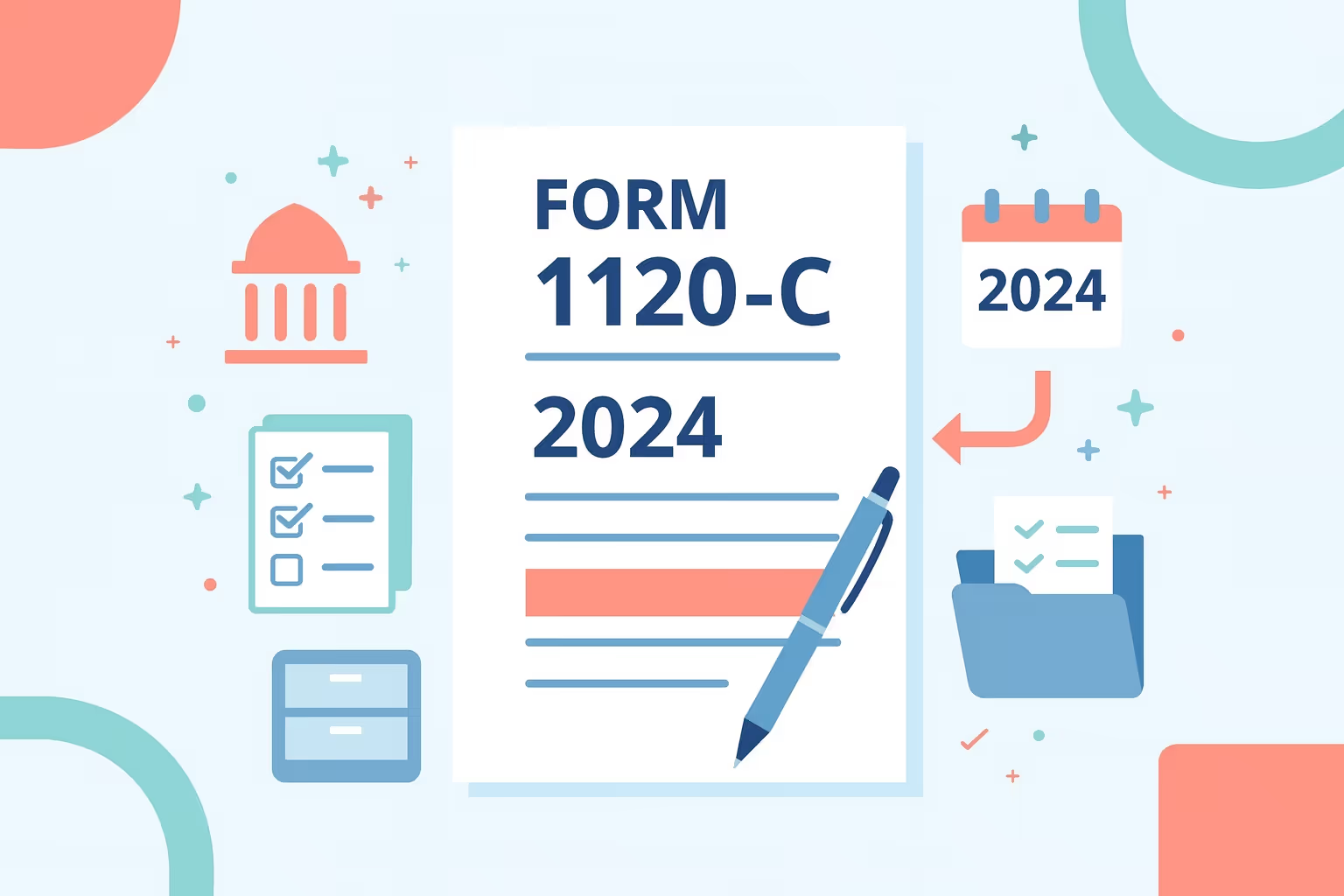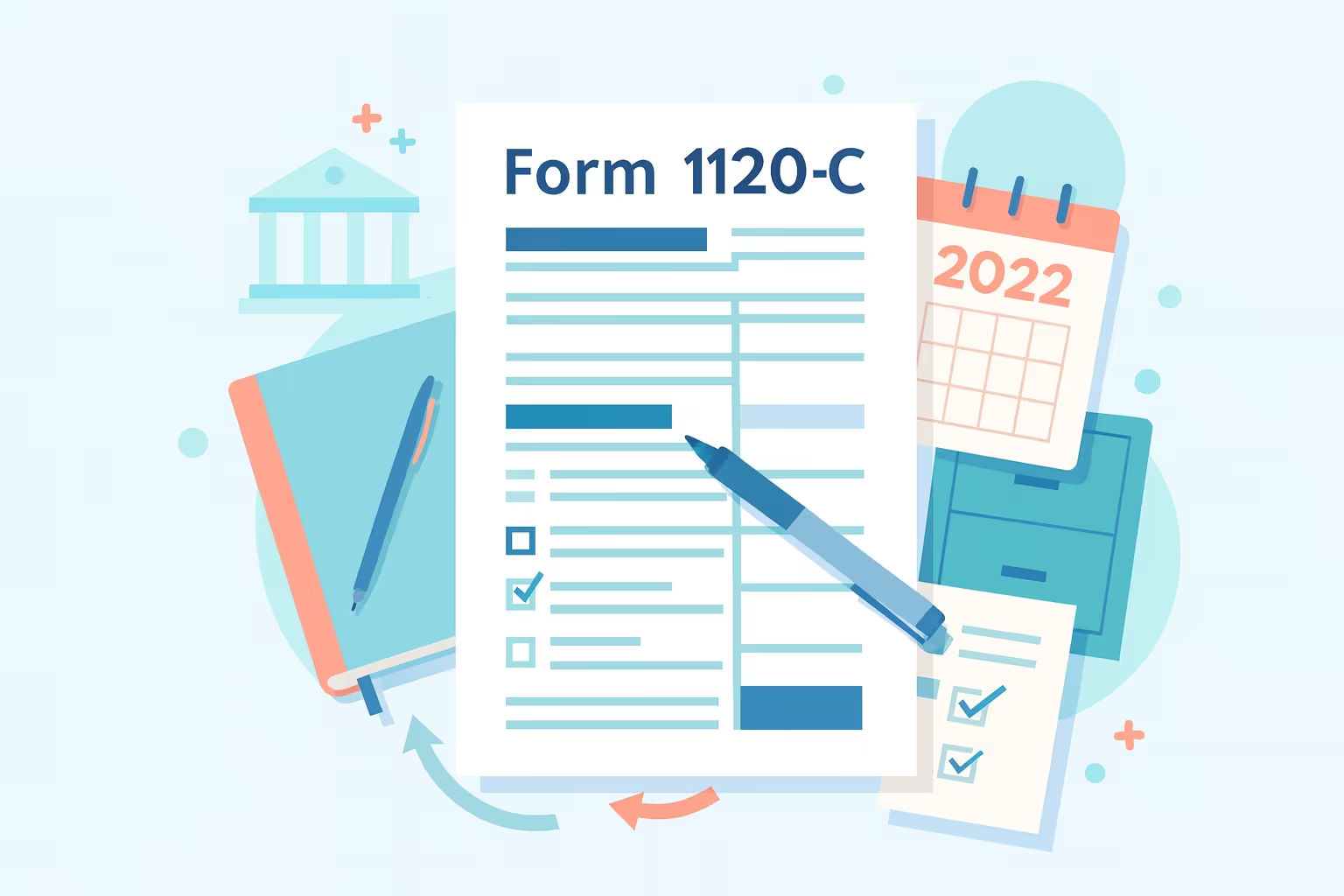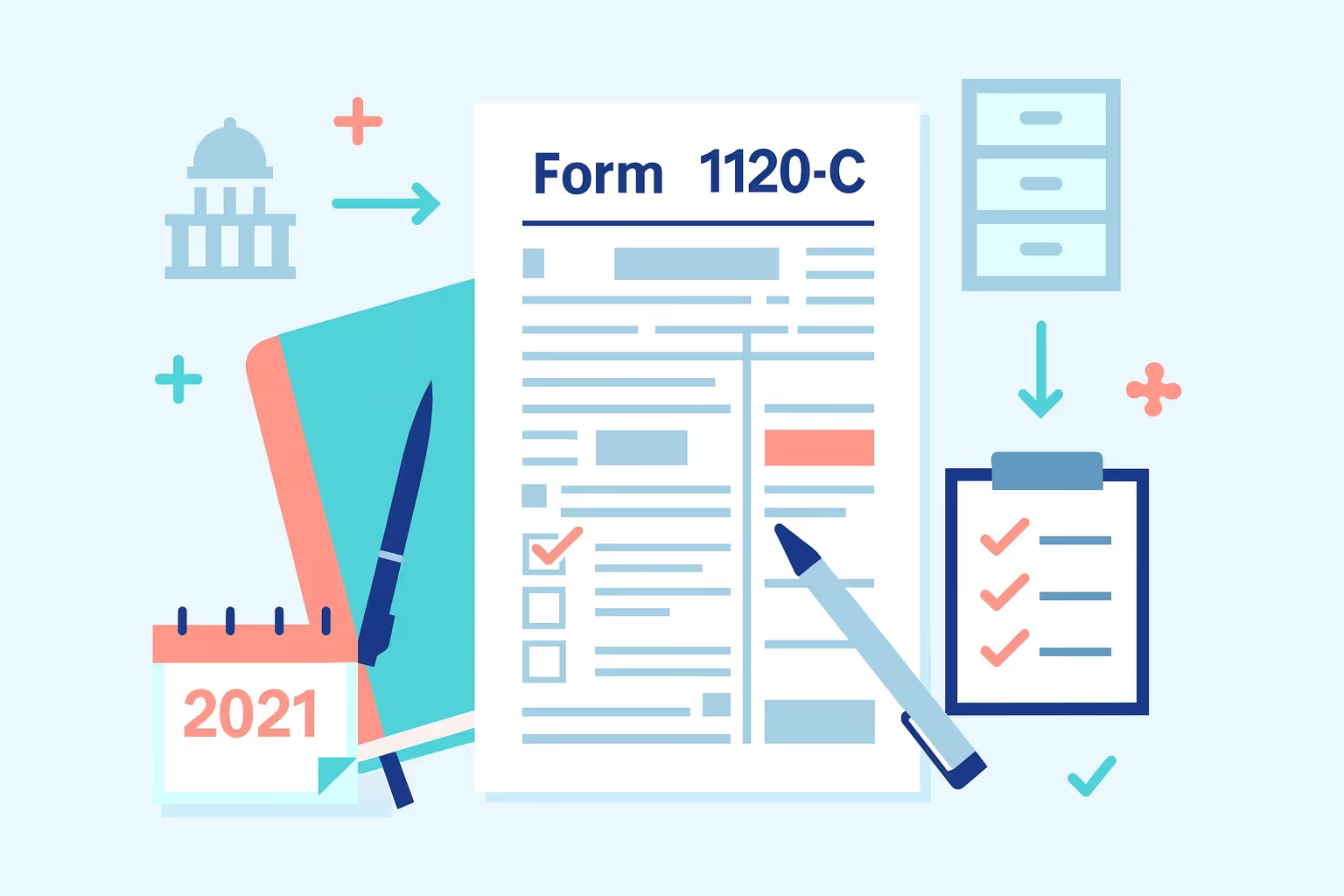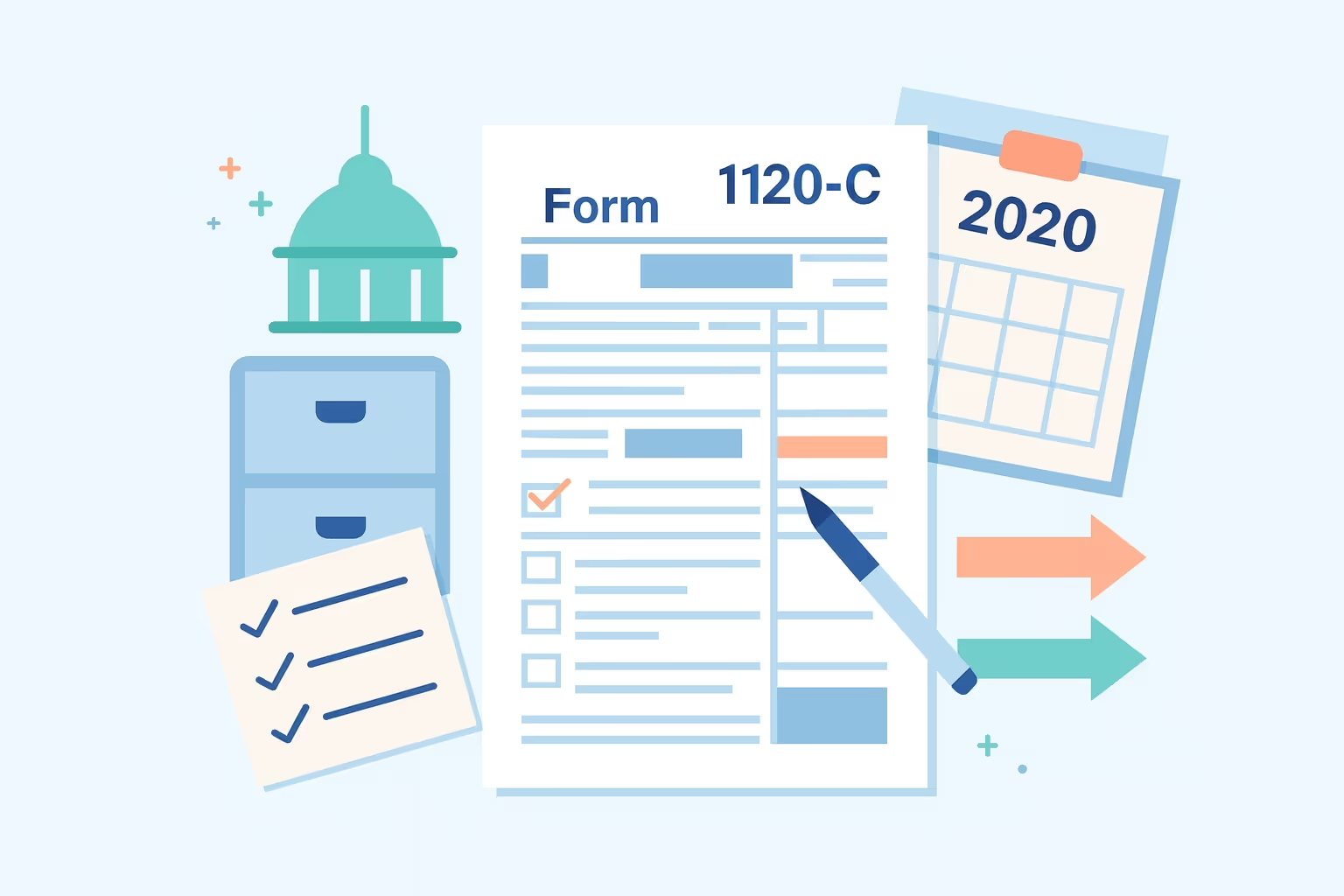
Cooperative associations serve a vital function in the U.S. economy by enabling members to share resources, reduce costs, and distribute profits fairly. Under the Internal Revenue Code, these organizations are required to comply with specific tax laws and filing requirements. To meet federal reporting standards, cooperatives file Form 1120-C, the Corporation Income Tax Return, which is used to disclose taxable income, tax-exempt income, and dividends paid to members. Completing this return accurately ensures compliance with Treasury Internal Revenue Service regulations and supports full disclosure for domestic and foreign corporations operating on a cooperative basis.
For the 2014 tax year, cooperatives faced multiple challenges in determining their total tax obligations, reporting income tax liability, and managing the accompanying schedules. Many entities needed to address updates in accounting method requirements, investment credit eligibility, and documentation of business interest expense. Accurate financial statements, prior-year carryovers, and estimated tax payments are essential for maintaining compliance. Proper recordkeeping helps ensure that all items, including real property trade activities and applicable tax rate computations, are reported correctly.
This article provides a clear, step-by-step guide on how to complete the 2014 Form 1120-C. According to the 2014 Instructions for Form 1120-C, cooperatives must prepare accurate schedules, calculate total tax, and disclose all relevant financial details to meet federal filing obligations.
Form 1120-C 2014 Instructions and Filing Requirements
Filing the 2014 Form 1120-C requires cooperative associations to identify their specific responsibilities under the Internal Revenue Code. This return serves as the official corporation income tax return for reporting taxable income, tax-exempt income, and dividends paid to members. Each cooperative must review its operations to determine whether it qualifies as a domestic or foreign corporation operating on a cooperative basis under Section 1381 of the Internal Revenue Code. Accurate reporting of income tax liability, total tax, and accompanying schedules supports transparency and ensures compliance with federal tax laws.
Cooperatives must meet strict eligibility conditions before filing. The organization must operate according to recognized cooperative principles, conduct business with its patrons, and allocate income through written notices that are qualified and provided promptly. Filers must also confirm whether they qualify as Section 521 tax-exempt organizations or non-exempt C corporations. Section 521 cooperatives receive special tax considerations, including the ability to exclude certain types of patronage income from taxable income reported. Non-exempt entities follow standard corporate tax treatment but may claim deductions for dividends paid to members.
Every cooperative must include complete identifying details on the return. The Employer Identification Number must appear exactly as issued. The name, address, and foreign postal code (if applicable) should match those on all supporting documents. Reporting must specify whether the entity is a parent corporation, a subsidiary in a group return, or an independent filer. Each filer must also disclose its business activity code, accounting method, and fiscal or calendar year-end. Domestic and foreign corporations engaged in cooperative operations must separate all patronage and non-patronage transactions for transparent reporting.
- Corporate Classification: Determine whether the filer is a domestic corporation, a foreign corporation, or a partnership treated as a corporation for tax purposes.
- Income Allocation: Distinguish taxable income, tax-exempt income, and amounts from foreign corporations or pass-through entities.
- Schedules and Attachments: Include all required accompanying schedules that detail officer compensation, business interest expense, and prior-year carryovers.
- Supporting Records: Attach financial statements showing total voting power, ownership percentages, and equity balances.
- Tax Computation: Reflect the applicable tax rate, credits, and estimated tax payments to reduce the final tax liability.
Filing Form 1120-C ensures the cooperative’s financial activity aligns with federal requirements. Completing all disclosures, separating domestic and foreign corporation income, and attaching each relevant schedule reduces audit risk and demonstrates compliance with the Treasury Internal Revenue Service standards. The following section outlines the step-by-step process for preparing the income tax return.
Preparing the Income Tax Return (Form 1120-C)
Preparing Form 1120-C for the 2014 tax year requires careful organization, accurate reporting, and adherence to the federal requirements outlined in the Internal Revenue Code. Cooperative associations must document every item of income, deduction, and credit to determine total tax and income tax liability correctly. Each step below ensures that the corporation income tax return includes every essential detail, from identification data to schedules supporting deductions and adjustments.
Step 1. Gather Essential Business and Financial Information
Collect all necessary records to complete the return. These include the Employer Identification Number, the official business name, and the current mailing address, including the foreign postal code if applicable. Assemble financial statements covering the entire tax year, noting gross receipts, dividends paid, and other property transactions. Review investment credit claims, business interest expense details, and prior-year carryovers to verify figures against ledger accounts.
Step 2. Verify Cooperative Structure and Filing Classification
Determine the cooperative’s legal status under the Internal Revenue Code. Identify whether the entity qualifies as a domestic corporation, foreign corporation, or parent corporation within a controlled group. Each classification determines how taxable income is reported and how accompanying schedules are prepared. Confirm whether the cooperative operates as a Section 521 tax-exempt organization or as a standard C corporation.
Step 3. Report Income and Gross Receipts
List all gross receipts from business operations, including sales, service revenue, and dividends received from domestic and foreign corporations. Exclude hybrid dividends and allocate income from activities conducted by foreign corporations. Each source of income must appear on the appropriate line to ensure accurate total income reporting.
Step 4. Record Allowable Deductions and Expenses
Deduct all legitimate business costs, including officer compensation, rents, wages, and business interest expense. Apply limits on excess business interest expense under Regulations Section 1.163(j). Include tax-exempt organization contributions within allowable thresholds. If applicable, report depreciation from real property trades or equipment purchases in accordance with approved accounting methods.
Step 5. Adjust Net Operating Losses and Special Items
Reconcile net operating losses carried forward from prior tax years and include any domestic corporations that claim the dividends-received deduction. Reflect adjustments for specific debt-financed stock and exclude hybrid dividends as required by regulation—review accompanying schedules to confirm that each adjustment aligns with recorded financial data.
Step 6. Complete Tax Computation and Payments
Calculate total tax using the applicable tax rate based on the cooperative’s taxable income. Subtract any investment credit, estimated tax payments, or qualified written notices affecting current-year liability. Disclose any prior-year carryovers and the effects of tax shelter transactions that influence the final tax liability.
Step 7. Assemble Accompanying Schedules and Supporting Records
Attach all required statements and schedules, including balance sheets, officer compensation details, and financial reconciliations. Ensure each document supports entries made on the corporation income tax return. Confirm that the totals match the financial statements and that all disclosures align with the requirements of the Treasury Internal Revenue Service.
A well-prepared Form 1120-C demonstrates compliance with 2014 federal tax laws and accuracy in financial reporting practices. Each verified figure helps maintain transparency, strengthens the cooperative’s audit readiness, and reflects adherence to established accounting standards.
Completing the filing with attention to every schedule and adjustment ensures that both taxable income and deductions are correctly represented. Consistent reporting builds trust with stakeholders and positions the cooperative for smooth future filings.
Tax Computation and Capital Gains
Determining total tax on Form 1120-C requires a detailed understanding of how the Internal Revenue Code applies to cooperative associations. Each filer must accurately compute taxable income and use the correct tax rate to establish its income tax liability.
The process involves identifying eligible credits, reviewing prior-year carryovers, and incorporating adjustments from investment credit claims. A cooperative’s final tax liability reflects taxable income, estimated tax payments, and any qualified written notices that reduce current-year obligations.
Calculating Total Taxable Income
Total taxable income reported should include all business activity conducted during the 2014 tax year. Cooperatives must combine patronage and non-patronage sources and subtract allowable deductions such as officer compensation, business interest expense, and depreciation from real property trade operations.
Accurately categorizing each type of income is essential for domestic and foreign corporations to prevent misstatements. Tax-exempt income must appear separately to avoid overstating taxable amounts subject to federal tax rates.
Tax computation also considers adjustments from specific debt-financed stock and dividends paid on preferred stock. Filers must account for net operating losses carried forward from prior tax years and properly allocate them between patronage and non-patronage activities. Transparent reporting supports compliance with Treasury Internal Revenue Service requirements and minimizes the risk of errors that could trigger inquiries or delays.
Reporting Capital Gains and Related Adjustments
Cooperative associations must report all sales or exchanges of capital assets, including investments, equipment, and other property, on Schedule D. Each transaction must indicate whether the gain or loss resulted from short-term or long-term holding periods. Foreign corporation activities involving lower-tier foreign corporation holdings or controlled foreign corporation shares require disclosure, notably when excluding hybrid dividends or applying tax treaties.
Capital gains from domestic corporations, pass-through entity interests, or tiered corporations must reflect accurate valuations and acquisition costs. Reporting these items correctly ensures proper inclusion in total income calculations and consistency with accompanying schedules. Cooperatives must reconcile their balance sheets with gains recognized during the year to demonstrate accuracy in asset tracking and tax basis adjustments.
A thorough computation of tax and capital gains confirms compliance with federal tax laws while reflecting the cooperative’s actual financial position. Precise calculations safeguard against understatement of income and strengthen documentation during future examinations. Detailed reporting facilitates clear communication with the Internal Revenue Service and ensures the consistent application of regulations. Accurate computations position cooperatives for timely 2014 filings.
Internal Revenue Service Guidance for 2014 Filers
The Treasury Internal Revenue Service introduced several 2014 updates affecting how cooperative associations file Form 1120-C. These changes improved reporting accuracy and brought consistency between financial statements and tax returns. Each cooperative must review updated requirements that govern capitalization, expense deductions, and reconciliation procedures for taxable income reported. Adhering to these updates ensures compliance with federal tax laws and reduces risks associated with misclassification or incomplete disclosures.
One major update involved the regulations for tangible property under Sections 162(a) and 263(a) of the Internal Revenue Code. These rules clarify when an expenditure may qualify as a current deduction versus a capitalized improvement. The changes apply to domestic and foreign corporations that acquire, produce, or improve property used in trade or business operations. Cooperative associations engaged in real property trade or equipment-intensive activities must carefully evaluate each asset’s classification and document the applicable accounting method.
Additional 2014 requirements affected large cooperatives responsible for reconciling book income with taxable income. The revised guidelines focus on transparency, consistency, and appropriate use of schedules:
- Schedule M-3 Reporting: Cooperatives with total assets exceeding $10 million are required to complete Schedule M-3, which details the differences between financial statement income and taxable income.
- Simplified Filing Option: Organizations with less than $50 million in assets may use Schedule M-1 instead of completing Parts II and III of Schedule M-3.
- Supporting Documentation: Cooperatives must maintain financial statements, balance sheets, and reconciliation schedules that align with each tax computation to ensure accurate reporting.
- Record Retention: Cooperatives must preserve detailed documentation, as required by the Paperwork Reduction Act Notice, to support every adjustment and calculation.
- Foreign Reporting Obligations: Controlled foreign corporation activities and tiered corporations must include disclosures reflecting foreign person ownership and exclusions for hybrid dividends.
The official 2014 Instructions for Schedule M-3 (Form 1120) outline filing thresholds, reconciliation requirements, and presentation standards that help cooperatives align book and taxable income. Applying these updates to the 2014 Form 1120-C enhances reporting accuracy and demonstrates compliance with Treasury standards.
Organizations that follow these guidelines enhance record reliability, reduce correction risks, and maintain transparency during reviews. Consistent compliance ensures sustainable filing practices and reinforces confidence in every stage of the reporting process.
Cooperative Associations and Tax-Exempt Status
Many cooperative associations operate under federal tax laws that distinguish between tax-exempt and non-exempt entities. Understanding eligibility for the Section 521 exemption is crucial for accurately filing Form 1120-C and reporting taxable income.
Qualifying for tax-exempt status affects how a cooperative calculates its income tax liability, deducts patronage dividends, and reports tax-exempt income. The following categories outline the key criteria, compliance factors, and reporting practices necessary for maintaining exemption and transparency.
Section 521 Eligibility
- Cooperatives must operate on a cooperative basis and allocate income through qualified written notices that reflect patronage activity.
- Cooperatives must be formed under state cooperative statutes and engage primarily in marketing member products or procuring supplies.
- Cooperatives must conduct at least 50 percent of their business with members to maintain their cooperative status.
- Cooperatives must derive most income from member-related transactions and maintain a clear separation from non-member activities.
- Cooperatives must distribute dividends paid on capital stock within allowable limits under Treasury Internal Revenue Service guidance.
Compliance and Documentation
- Cooperatives must apply consistent accounting methods to accurately record both patronage and non-patronage income.
- Cooperatives must maintain balance sheets that show total voting power, percentage ownership, and capital retained by members.
- Cooperatives must file returns and make estimated tax payments on time to maintain their cooperative status.
- Cooperatives must retain documentation verifying qualified written notices, cash distributions, and debt-financed stock allocations.
- Cooperatives must provide clear schedules reconciling taxable income reported with exemptions claimed.
Reporting Requirements
- Cooperatives must identify any foreign person, controlled foreign corporation, or parent corporation with a significant interest.
- Cooperatives must report publicly offered debt instruments, specific preferred stock, and other property affecting cooperative equity.
- Cooperatives must track prior-year carryovers and allocate them between taxable and exempt income sources.
- Cooperatives must record allowable amounts and reconcile any excess business interest expense under Regulations Section 1.163(j).
- Cooperatives must comply with Internal Revenue Code provisions and avoid classifying unrelated business income as exempt from taxation.
Correctly identifying tax-exempt status under Section 521 ensures the cooperative receives applicable benefits while maintaining federal compliance. Each organization must review its operations, financial records, and member relationships annually to confirm ongoing eligibility. Meeting these requirements reinforces trust with both members and tax authorities. Accurate reporting safeguards exemption rights and establishes a consistent framework for future tax years.
Patronage Dividends and Tax Implications
Patronage dividends are a defining feature of cooperative associations and directly influence how taxable income is calculated under the Internal Revenue Code. These payments represent each member’s share of the cooperative’s earnings from patronage-based activities.
Understanding how to classify, deduct, and report them is essential for maintaining compliance with Internal Revenue Service requirements. The points below explain how patronage dividends affect total tax, income tax liability, and overall reporting for 2014 Form 1120-C filers.
Definition and Purpose
- Patronage dividends are amounts distributed to members in proportion to their business with the cooperative, reducing taxable income when properly allocated.
- The primary purpose of distributing patronage dividends is to return surplus earnings from member-based transactions, reinforcing cooperative principles.
- Only income derived from patronage activity qualifies for allocation, while non-patronage earnings remain subject to corporate taxation.
Timing and Deductibility
- Cash distributions are deductible in the tax year they are paid to members, which directly impacts the cooperative’s total tax computation.
- Qualified written notices are deductible when issued, provided they meet the requirements of Section 1382, including acceptance by the patron.
- Distributions of other property are deductible at fair market value when documentation supports both the valuation and the ownership transfer.
- Allocation methods must remain consistent from year to year and reflect both patronage volume and the percentage owned by each member.
Reporting and Documentation
- Financial statements must specify dividends paid and categorize them accurately, distinguishing between cash, written notices, and property.
- Supporting records must include detailed schedules that show how each distribution affects taxable income, net operating losses, and prior-year carryovers.
- Balance sheets must show patronage allocations as reductions to retained earnings while reconciling changes with capital accounts.
- Ownership disclosures must identify every foreign corporation, foreign person, or tiered corporation involved in dividend participation or equity interest.
Tax Treatment Considerations
- Hybrid dividends and non-patronage allocations must remain excluded from patronage deduction claims to prevent overstatement of deductions.
- Regulations covering certain debt-financed stock transactions must be applied when calculating deductible amounts.
- Coordination between the use of investment credit and patronage dividend deductions must remain consistent with applicable tax laws.
- Deductions under Section 163(j) for business interest expense must align with adjustments related to patronage distributions.
Publication 225: Farmer’s Tax Guide (2014) explains cooperative-specific rules for allocating and deducting patronage dividends. Accurate classification ensures each deduction reflects genuine patronage activity and meets federal requirements.
Thorough documentation reinforces accuracy during audits and ensures the integrity of the reporting process. Consistency across tax years supports transparency, strengthens governance, and promotes long-term compliance with Internal Revenue Service standards.
Balance Sheets, Financial Reporting, and Tax Professionals
Accurate balance sheets and financial statements form the foundation of every cooperative association’s Form 1120-C filing. These records capture all transactions involving assets, liabilities, and equity for the reporting period.
Properly prepared statements demonstrate compliance with the Internal Revenue Code, support accurate total tax calculations, and reflect transparency in financial management. Maintaining detailed schedules and supporting documentation also ensures alignment between taxable income reported and financial disclosures made to the Internal Revenue Service.
Balance sheets must include all relevant financial data that reflect the cooperative’s actual financial position. Each figure reported should correspond to the accounting method applied and reconcile with items such as business interest expense, investment credit, and prior-year carryovers. The goal is to present a complete financial picture that can be verified through documentation and member records.
- Include all assets, such as real property trade holdings, investments, and other property that influence depreciation and capital calculations.
- Disclose all liabilities, including publicly offered debt instruments, debt-financed stock, and business activity-related obligations.
- Record total voting power and ownership percentages to show equity distribution across members and affiliates.
- Track retained earnings, dividends paid, and cash distributions to maintain consistency across financial statements and tax returns.
- Reflect all adjustments from prior tax years and verify that any foreign corporation activities or controlled foreign corporation holdings are accurately stated.
- Reconcile financial statements with schedules on the corporation income tax return, ensuring each entry supports reported taxable income and deductions.
Professional assistance enhances accuracy when complex ownership structures or foreign reporting requirements exist. A qualified tax professional can review controlled foreign corporation disclosures, investment credit claims, and computations for excess business interest expense under Section 163(j). Cooperatives managing multiple schedules, including balance sheets and officer compensation details, may benefit from advisory support to ensure proper treatment of all entries.
Reliable financial reporting promotes transparency, supports cooperative governance, and reduces the risk of compliance errors. Engaging an experienced preparer provides oversight on technical matters and confirms that all figures align with Treasury requirements. Comprehensive documentation and professional review enhance confidence in every filing and prepare the cooperative for future audits or regulatory examinations.
Frequently Asked Questions
What types of cooperatives must file Form 1120-C for 2014?
Cooperative associations that operate under Section 1381 of the Internal Revenue Code must file Form 1120-C for the 2014 tax year. This includes agricultural organizations, marketing cooperatives, and any farming business engaged in transactions with members. Entities with patronage and non-patronage income must report both categories separately. Each filer should review its governing documents, ownership structure, and accounting method to confirm eligibility before preparing the corporation income tax return.
How does a cooperative apply tax credits on Form 1120-C?
Cooperatives may claim tax credits to offset total tax liability when computing federal income tax. Eligible credits can include general business credits, research-related incentives, or the investment credit for qualifying assets. Each credit must appear on the proper schedule, accompanied by documentation that supports the calculation methods and applicable carryovers. Filers must ensure their financial statements align with claimed credits to demonstrate compliance and avoid underreporting taxable income during IRS examinations.
When should a cooperative use a paid preparer for Form 1120-C?
A cooperative should engage a paid preparer when its financial reporting involves complex activities such as tiered ownership, hybrid dividends, or multiple schedules. A qualified preparer ensures accuracy in taxable income, deductions, and tax credits while verifying conformity with Internal Revenue Code requirements. Professional guidance is especially valuable for organizations that allocate patronage dividends or maintain significant investments. Using a preparer supports compliance and enhances audit readiness through complete and properly documented returns.
What ownership details must be reported when one foreign person holds an interest?
If one foreign person owns 25 percent or more of a cooperative’s voting stock, the organization must disclose ownership details on Form 1120-C. The filing must include identifying information about the shareholder and any affiliated foreign corporation. Accurate reporting demonstrates compliance with international tax provisions and supports proper taxation of cross-border income. Cooperatives must retain records confirming ownership percentages and document all related-party transactions in their financial statements.
How should a cooperative report investment credit on Form 1120-C?
A cooperative claiming an investment credit must document eligible property, acquisition dates, and qualifying expenditures. The credit should offset part of the total tax while reflecting compliance with Internal Revenue Code Section 46 requirements. Supporting schedules must reconcile with financial statements and indicate whether the asset is related to a farming business or a production activity. Accurate reporting ensures transparency in credit usage and substantiates the deduction during Treasury Internal Revenue Service reviews.
Can an S corporation qualify as a cooperative for Form 1120-C?
An S corporation cannot file Form 1120-C because it follows different taxation rules under Subchapter S of the Internal Revenue Code. Only entities operating as C corporations on a cooperative basis can submit Form 1120-C. Organizations structured as S corporations may engage in member services; however, their income, deductions, and tax credits are passed through to shareholders rather than being reported at the corporate level for federal tax purposes.
What topics can the IRS discuss during a cooperative audit?
During an audit, the IRS may discuss issues related to taxable income reporting, investment credit eligibility, and patronage dividend allocations. Examiners may review the cooperative’s accounting method, financial statements, and ownership of voting stock. Discussions may also address tax credits, prior-year carryovers, or the treatment of hybrid dividends. Maintaining thorough records, clear schedules, and proper documentation supports accuracy and helps resolve questions efficiently during the examination process.

























